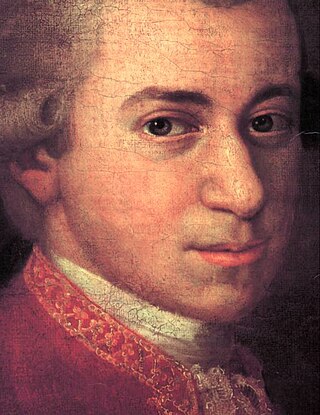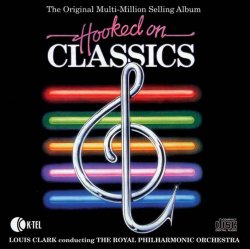Related Research Articles

The Piano Sonata No. 11 in A major, K. 331 / 300i, by Wolfgang Amadeus Mozart is a piano sonata in three movements.
The Piano Sonata No. 16 in C major, K. 545, by Wolfgang Amadeus Mozart was described by Mozart in his own thematic catalogue as "for beginners", and it is sometimes known by the nickname Sonata facile or Sonata semplice. Despite this, the sonata is actually not an easy work to perform and can hardly be described as "for beginners."

Eine kleine Nachtmusik, K. 525, is a 1787 composition for a chamber ensemble by Wolfgang Amadeus Mozart (1756–1791). The German title means "a little night music". The work is written for an ensemble of two violins, viola, cello and double bass, but is often performed by string orchestras. The serenade is one of Mozart's most famous works.

The Piano Sonata No. 13 in B-flat major, K. 333 (315c), also known as the "Linz Sonata", was composed by Wolfgang Amadeus Mozart in Linz at the end of 1783.
The Divertimento in E♭ major, K. 563, is a string trio, written by Wolfgang Amadeus Mozart in 1788, the year in which he completed his last three symphonies and his "Coronation" Piano Concerto. It is his last divertimento and different from his other divertimenti not only in its instrumentation but also in its compositorial ambition and scope.

The Serenade No. 10 for winds in B-flat major, K. 361/370a, is a serenade by Wolfgang Amadeus Mozart scored for thirteen instruments: twelve winds and string bass. The piece was probably composed in 1781 or 1782 and is often known by the subtitle Gran Partita, though the title is a misspelling and not in Mozart's hand. It consists of seven movements.

Wolfgang Amadeus Mozart's Piano Sonata No. 6 in D major, K. 284 / 205b, (1775) is a sonata in three movements:
The Milanese Quartets, K. 155–160, are a set of six string quartets composed by Wolfgang Amadeus Mozart in late 1772 and early 1773 when he was sixteen and seventeen years old. They are called 'Milanese' because Mozart composed them in Milan while he was working on his opera Lucio Silla. Before this set was composed, Mozart had written one earlier string quartet, so these six quartets are numbered from No. 2 to No. 7. The quartets are written in a plan of keys of D–G–C–F–B♭–E♭ following the circle of fourths.
The six string quartets, K. 168–173, were composed by Wolfgang Amadeus Mozart in late 1773 in Vienna. These are popularly known as the Viennese Quartets. Mozart may have hoped to have them published at the time, but they were published only posthumously by Johann André in 1801 as Mozart's Op. 94.

The Piano Sonata in B-flat major, K. 498a, is a piano sonata in four movements. It was first printed in 1798 by P. J. Thonus in Leipzig on behalf of Breitkopf & Härtel and attributed to Wolfgang Amadeus Mozart; an edition printed in c. 1805 already credited it as opus 26 of the Thomascantor August Eberhard Müller (1767–1817). Some publications still attribute it to Mozart, often as Piano Sonata No. 20.
The London Sketchbook (German: Londoner Skizzenbuch), K.15 a–ss (Anh. 109b) is a series of 43 untitled pieces and sketches written by Wolfgang Amadeus Mozart between 1764 and 1765 while in London (see the Mozart family's grand tour). The set of works is denoted by its K6 number, followed by its respective letter, i.e. 15a, 15b, 15c, etc.
Sonatas, duos and fantasies by Franz Schubert include all works for solo piano by Franz Schubert, except separate dances. They also include a number of works for two players: piano four hands, or piano and a string instrument.

Hooked on Classics, produced by Jeff Jarratt and Don Reedman, is a multi-million selling album recorded by Louis Clark and the Royal Philharmonic Orchestra, published in 1981 by K-tel and distributed by RCA Records, part of the Hooked on Classics series.
The Divertimento No. 17 in D major, K. 334/320b was composed by Wolfgang Amadeus Mozart between 1779 and 1780 and was possibly composed for commemorating the graduation of a close friend of Mozart's, Georg Sigismund Robinig, from his law studies at the University of Salzburg in 1780. Lasting about 42 minutes, it is the longest of the divertimenti by Mozart.

The Piano Quartets, WoO 36, by Ludwig van Beethoven are a set of three piano quartets, completed in 1785 when the composer was aged 14. They are scored for piano, violin, viola and cello. He composed a quartet in C major, another in E-flat major, and a third in D major. They were first published posthumously in 1828, however numbered in a different order: Piano Quartet No. 1 in E-flat major, Piano Quartet No. 2 in D major, and Piano Quartet No. 3 in C major.
References
- ↑ Köchel's Catalogue of Mozart's Works
- ↑ premiered on YouTube in January 2021.